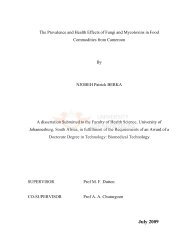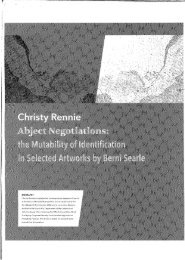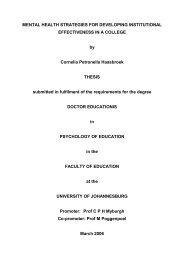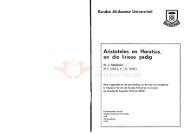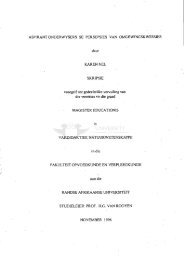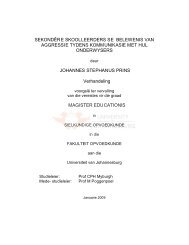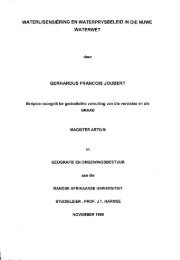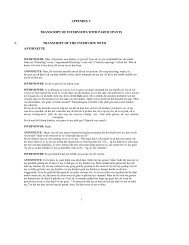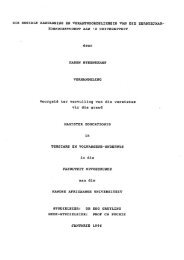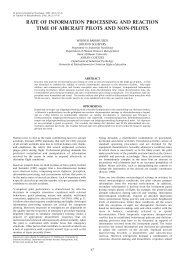View/Open - UJDigispace
View/Open - UJDigispace
View/Open - UJDigispace
Create successful ePaper yourself
Turn your PDF publications into a flip-book with our unique Google optimized e-Paper software.
Chapter 5<br />
Investigation into the genera within the subfamily<br />
Mesembryanthemoideae, excluding Sceletium and<br />
Aptenia<br />
5.1 Introduction<br />
The sub-family Mesembryanthemoideae comprise 11 genera and 95 species. 1,2<br />
The genus Sceletium was discussed in Chapter 3 and the genus Aptenia in<br />
Chapter 4. According to Klak et al. 3 (2003) these two genera are closely related.<br />
In this chapter, the remaining nine genera of “weedy mesembs” are discussed. It<br />
is mentioned in Klak et al. (2003) that the relationships and generic<br />
circumscriptions of these genera are likely to change. The genus<br />
Mesembryanthemum L., for example, comprises at least three unrelated lineages.<br />
These remaining nine genera are:<br />
Aridaria N.E.Br., Aspazoma N.E.Br., Brownanthus Schwantes, Caulipsolon Klak,<br />
Mesembryanthemum, Phyllobolus N.E.Br., Prenia N.E.Br., Psilocaulon N.E.Br., and<br />
Synaptophyllum N.E.Br. 1,4<br />
The genus name Aridaria is derived from the Latin word aridus, meaning dry, in<br />
allusion to the arid natural habitat of plants of this genus. 1 Four species of Aridaria<br />
are currently recognised. These include A. brevicarpa L. Bolus (Fig. 5.1), A.<br />
noctiflora (L.) Schwantes (Fig. 5.1), A. serotina L. Bolus (Fig. 5.1), and A.<br />
vespertina L. Bolus. 1,4 The species A. noctiflora is commonly known as<br />
brakveldwitvygie (brack field white mesemb). 1 The flowering season for plants of<br />
this genus is mainly between spring and early summer and depending on the<br />
species, the flowers open during the day, evening or night. 1 One of the main<br />
characters used to distinguish between species within the genus is the time at<br />
57
which the flowers open, and this may vary from during the day only (A.<br />
brevicarpa) to only at night (A. noctiflora). 1<br />
Figure 5.1: A. noctiflora, A. brevicarpa and A. serotina.<br />
Photographs from Smith et. al. 1998. 1<br />
The Greek word aspazomai (to clasp) is the origin of the genus name Aspazoma,<br />
and refers to the way in which the leaf sheath clasps the stem in plants of this<br />
genus. 1 Only one species of Aspazoma is currently recognised, A. amplectens (L.<br />
Bolus) N.E.Br., and no vernacular names appear to have been recorded. 1,4<br />
Flowering time for Aspazoma is during spring. It is to be noted that Aspazoma is<br />
closely related to Brownanthus, the main distinguishing characters being the<br />
arrangement of the leaves and the very large seeds in Aspazoma. It is considered<br />
that these two genera may eventually be combined. 1<br />
Figure 5.2: Growth form, flowers and leaves of Aspazoma amplectens.<br />
Photographs from Smith et. al. 1998. 1<br />
58
The genus Brownanthus was named after the mesemb expert Dr. N.E. Brown<br />
(1849-1934) who worked at Kew. 1,5 Dr. Brown’s name is combined with the<br />
Latinised form of the Greek word anthos, meaning flower. 1 Ten species of<br />
Brownanthus are currently recognised, and no vernacular names are recorded for<br />
any of these species. 1,4 The flowers of plants of this genus appear from spring to<br />
early summer, and the flowers open during daylight hours. Originally Brownanthus<br />
was included in Psilocaulon, but was later shown to be different in respect of fruit,<br />
flowers and leaf surfaces. 1 Figure 5.3 shows Brownanthus pubescens (N.E.Br. ex<br />
Maas) Bullock, B. marlothii (Pax) Schwantes, and the flowers of B. ciliatus (Aiton)<br />
Schwantes.<br />
Figure 5.3: Brownanthus pubescens, B. marlothii, and flowers of B. ciliatus.<br />
Photographs from Smith et. al. 1998. 1<br />
The genus name Caulipsolon is an anagram of Psilocaulon, the genus in which it<br />
was previously placed. 1 One species is currently recognised, C. rapaceum (Jacq.)<br />
Klak (Fig. 5.4), and no vernacular names seem to have been recorded. 1,4 The<br />
genus Caulipsolon is characterized by creeping annual stems and a tuberous root<br />
stock. The stems and leaves have smooth surfaces, and the fruit have a<br />
distinctively funnel-shaped lower part. 1 The plant flowers between late winter and<br />
early spring. 1<br />
59
Figure 5.4: Caulipsolon rapaceum and its tuberous rootstock.<br />
Photographs from Smith et. al. 1998. 1<br />
The genus name Mesembryanthemum has a complicated derivation. The name<br />
Mesembryanthemum is derived from the Greek words mesos (in the centre),<br />
embryon (pistil or embryo), and anthemon (flower), meaning “a flower with a<br />
pistil or embryo in the centre”. 1 However, the name Mesembrianthemum, from<br />
which the genus name originated, referred to the opening of the flowers of many<br />
mesemb species during midday. 1,5 Fifteen species of Mesembryanthemum are<br />
currently recognised. 1,4 Recorded common names for plants of this genus include<br />
ice plant, brakslaai (brack salad), brakvy (brack mesemb), olifantslaai (elephant<br />
salad), volstruisslaai (ostrich salad), slaaibos (salad bush), soutslaai (salt salad),<br />
kama, nuta, and rosa-de-jericho. Mesembryanthemums are often large-leaved<br />
fleshy herbs, and most species are covered with prominent water cells. The<br />
lettuce-like appearances of some species, as well as their abundance at some<br />
localities, make them easy to identify. The flowering season is mainly in the spring<br />
and summer months, with the flowers opening in the morning and closing at<br />
night. 1 Figure 5.5 shows Mesembryanthemum guerichianum Pax and a<br />
Mesembryanthemum sp. with the water cells clearly visible.<br />
60
Figure 5.5: Mesembryanthemum guerichianum and Mesembryanthemum sp.<br />
clearly showing water cells.<br />
Photographs from Smith et. al. 1998. 1<br />
The genus name Phyllobolus is derived from the Greek word phyllon (meaning<br />
leaf) and from the Latin word bolus (meaning to throw or cast) in reference to the<br />
deciduous leaves of some species. Thirty-two species of Phyllobolus are currently<br />
recognised. Phyllobolus digitatus (Aiton) Gerbaulet (Fig. 5.6) is commonly known<br />
as vingerkanna (finger kanna) and vingertjie-en-duimpie (finger and thumb). In<br />
the USA, this species is also known as the hitchhiker plant due to its distinct<br />
growth form. The common name brakveldvygie is used to refer to P. splendens<br />
(L.) Gerbaulet, and P. rabiei (L. Bolus) Gerbaulet is known as oumasepram<br />
(vygie). Plants of the genus Phyllobolus flower mainly from mid-winter to midsummer.<br />
The flowers close at night in most species, although some are known to<br />
bear night-opening flowers and others never close. 1<br />
Figure 5.6: Phyllobolus digitatus subsp. digitatus, also known as vingertjie-enduimpie<br />
or the hitchhiker plant.<br />
Photograph: Candice. D. Gaffney.<br />
61
The Greek word prenes, meaning prostrate, is the origin of the genus name<br />
Prenia in reference to the creeping habit of these plants. 1 Six species of Prenia are<br />
currently recognized. 1,4 These include P. englishiae (L.Bolus) Gerbaulet, P. pallens<br />
Aiton) N.E.Br. (Fig. 5.7), P. radicans (L. Bolus) Gerbaulet, P. sladeniana L. Bolus<br />
(Fig. 5.7), P. tetragonal (Thunb.) Gerbaulet, and P. vanrensburgii L. Bolus. 1,4 Only<br />
two of these species have known common names. P. vanrensburgii is known as<br />
seepampoen (sea pumpkin), and P. sladeniana is known as skotteloor (disc ear).<br />
The flowers of plants of the genus Prenia open by day, and they flower from<br />
spring through summer to autumn. 1<br />
Figure 5.7: Prenia sladeniana and P. pallens subsp. lutea.<br />
Photographs from Smith et. al 1998. 1<br />
The leafless stems of plants of the genus Psilocaulon led to the genus name,<br />
which is derived from the Greek words psilos (meaning bare, bald, or smooth) and<br />
kaulos (meaning stalk). 1 Within the genus, 13 species are currently recognized. 1,4<br />
Commonly used vernacular names for plants of this species include asbos (ash<br />
bush), loogasbossie (lye ash bush), seepbossie (little soap bush), or grootlidjies<br />
(large jointlets). P. dinteri (Engler) Schwantes is commonly known as<br />
skerpioenvygie (scorpion mesemb), due to its resemblance to a scorpion. Young<br />
stems of Psilocaulon plants are jointed, succulent and green, while old stems<br />
become woody. Flowering time for plants of this genus is from early to midsummer.<br />
1 Psilocaulon junceum (Haw.) Schwantes and the flowering stems of P.<br />
articulatum (Thunb.) N.E.Br. can be seen in Figure 5.8.<br />
62
Figure 5.8: Psilocaulon junceum and flowering stems of P. articulatum.<br />
Photographs from Smith et. al. 1998. 1<br />
The genus name Synaptophyllum is derived from the Greek words synaptos<br />
(meaning gnarled) and phyllos (meaning leaf). 1 Only one species of<br />
Synaptophyllum, S. juttae (Dinter & A.Berger) N.E.Br., is currently recognized and<br />
no vernacular names appear to have been recorded. 1,4 Synaptophyllum is a<br />
particularly interesting mesemb in that it has a very restricted distribution. It is<br />
only known to grow in the fog zone of the southern Namib desert, near Lüderitz in<br />
south-western Namibia. The single species of Synaptophyllum is a desert<br />
specialist, which flowers in midsummer. 1<br />
Figure 5.9: Flowering form of Synaptophyllum juttae, and young plant of S. juttae<br />
showing the large basal leaves.<br />
Photographs from Smith et. al. 1998. 1<br />
63
5.2 Literature Review<br />
Very little information is available in the literature on the chemistry of the genera<br />
of the Mesembryanthemoideae, with the exception of Aptenia and of Sceletium. 6<br />
In 1914, Zwicky tested several Mesembryanthemoideae for the presence of<br />
alkaloids using general alkaloidal tests. 7 Only five of six genera of<br />
Mesembryanthemoideae tested thus far have tested positive for alkaloids. 8 These<br />
are Aptenia, Sceletium, Aridaria, Prenia and Psilocaulon. 7,8 It should be stressed<br />
that the tests performed, however, were non-quantitive general alkaloid tests and<br />
do not necessarily indicate only mesembrine-like alkaloids. 8 Hordenine (36) is a<br />
non-mesembrane alkaloid whose presence in plants of the subfamily<br />
Mesembryanthemoideae has previously been reported, as is the case with<br />
piperidine. 7,8,9,10 The presence of oxalic acid and oxalates have also previously<br />
been reported in the Mesembryanthemoideae. 6,7,8,11,12 It is also significant to note<br />
that within the genera of the Mesembryanthemaceae, different species have<br />
tested both alkaloid positive and negative. 8<br />
In 1928, Laidler reported that the plant Mesembryanthemum crystallinum, also<br />
known as slaai, was used for removing hair off animal skins and was still in use<br />
among farmers at the time. 8,11 In the same article, Laidler reported that a plant<br />
named Mesembryanthemum stellatum, also known as karremoer, was one of the<br />
beer-making roots, a deliriant and intoxicant with stimulant action. 11 Watt and<br />
Breyer-Brandwijk reported in 1962 that Mesembryanthemum aitonis has been<br />
suspected of producing field poisoning of cattle in the Grahamstown district. 7 They<br />
wrote:<br />
‘Experimentally the administration of 4 kg. to a sheep has resulted in listlessness,<br />
anorexy, tympanites, dyspnoea, quickening and weakening of the pulse, slight<br />
diarrhoea and arching of the back, with recovery. ’7<br />
It is reported in the literature that several species of Mesembryanthemum (which<br />
have not been fully determined) are traditionally used in a variety of ways. 7<br />
64
Thunberg reported that the early colonists used to administer a concoction of the<br />
fruit of Mesembryanthemum sp. to expectant women near term to ease delivery.<br />
A Mesembryanthemum sp. was used by the Swati in the treatment of cystitis. An<br />
enema of a Mesembryanthemum sp. is used by the Zulu people to treat stomach<br />
upsets. A similar preparation is sometimes drunk to quell nausea, and the Zulus<br />
rub the ash of this species into lacerations made over various parts of the body<br />
that are sore. The Europeans used to drink an infusion of the leaf of<br />
Mesembryanthemum sp. and they applied the leaf locally for the treatment of skin<br />
sores. The Zulu use an infusion of the leaf of Mesembryanthemum sp. to alleviate<br />
the nightmares that apparently accompany heart weakness. In the old Transvaal,<br />
a mixture of the juice of the leaf of a Mesembryanthemum sp. and the juice of a<br />
Tragia sp. were taken to treat syphilis. 7<br />
Watt and Breyer-Brandwijk reported in 1962 that Psilocaulon absimile N.E.Br. had<br />
caused stock poisoning in the Willowmore district, and that sun drying did not<br />
diminish the toxicity of the plant. 7 They reported that the plant contains two lethal<br />
compounds, piperidine and oxalic acid. 7,8 The ash of Psilocaulon parviflorum<br />
Schwantes is reported to have been employed by the African people and by the<br />
Khoi people in soap-making. 7 The ash has also reportedly been used in the<br />
Worcester district as a lye in which grapes are steeped when making raisins. 7 The<br />
ash of another two species, P. junceum and P. coriarium, has been used as lye in<br />
soap-making. 1 In the north-western Cape, Psilocaulon species are used to erect a<br />
asbosskerm or kookskerm (a traditional shelter around the fireplace) by stacking<br />
the plants up to a height of around 2,5 m. 1<br />
5.3 Results and Discussion<br />
In this chapter, six of the nine remaining genera of the Mesembryanthemoideae<br />
are investigated for the presence of mesembrane alkaloids. The genera<br />
investigated are Aridaria (1 species, 1 plant), Brownanthus (1 species, 2 plants),<br />
Mesembryanthemum (5 or 6 species, 13 plants), Phyllobolus (7 species, 7 plants),<br />
Prenia (between 2 and 4 species, 5 plants) and Psilocaulon (6 species, 17 plants).<br />
65
Where sufficient material was available, extracts of the various parts of the plants<br />
were prepared, i.e. extracts of fruit and flowers, leaves, stems, and roots. Where<br />
insufficient material was available to be separated into plant parts, the material<br />
that could be obtained was extracted as a single extract and named ‘mixed plant<br />
parts’. Comprehensive information on all plants screened in this study can be<br />
found in Tables 7.1 and 7.2 of Chapter 7, as well as Tables A.1 and A.2 in<br />
Appendix 1.<br />
Alkaloid extracts of all of the Mesembryanthemoideae plants investigated in this<br />
study were prepared, and analysed by TLC and GC-MS as described in Chapter 7.<br />
As the bulk extraction of the roots of Phyllobolus digitatus subsp. digitatus roots<br />
yielded a fair amount of extract, the crude alkaloid extract of this sample was<br />
separated into various fractions using a chromatotron. All the<br />
Mesembryanthemoideae extracts that had screened positive for nitrogencontaining<br />
compounds on TLC were then analysed using Gas Chromatography<br />
/Mass Spectrometry (electron impact ionisation). Once again, a mesembrine (10)<br />
standard was used to ascertain the retention time of mesembrine on the GC. by<br />
NMR spectroscopy (Fig 3.2) allowed the identification of the alkaloid mesembrine<br />
in the standard. Structures of the other compounds were elucidated based on<br />
their respective mass spectra.<br />
As mentioned in Chapters 3 and 4, it is evident from the literature that four<br />
fragments are often observed to be present on the GC/MS spectra of the<br />
mesembrane alkaloids. The peaks of these four fragments are at m/z 44, m/z 58,<br />
m/z 72 and m/z 219. The ion that results in a peak at m/z 219 is considered to be<br />
characteristic of the mesembrine-type of mesembrane alkaloids. The structures of<br />
the four ions are given in Figure 3.5.<br />
Only one species of Aridaria could be obtained to investigate the presence of<br />
mesembrane alkaloids. The Aridaria serotina plant was separated into leaves,<br />
roots and stems. The extracts of all three plant parts screened positive for<br />
nitrogen-containing compounds on TLC and were subsequently analysed using<br />
66
GC/MS, where they were found to contain mesembrane alkaloids. The distribution<br />
of the mesembrane alkaloids between the various parts of Aridaria serotina can be<br />
seen in Table 5.1.<br />
The four alkaloids observed to be present in the various plant parts of Aridaria<br />
serotina are mesembrine (10), mesembrenone (11), mesembranol (13) and<br />
hordenine (36). The main alkaloid present in the leaves of A. serotina was<br />
mesembrine (10), followed by mesembranol (13) and then mesembrenone (11).<br />
No hordenine (36) was found in the leaves. In the stems of A. serotina,<br />
mesembrine (10) was once again the most predominant alkaloid, followed by<br />
mesembrenone (11), hordenine (36) and then mesembranol (13).<br />
Mesembrenone (11) was the main alkaloid found in the roots of A. serotina,<br />
followed by mesembrine (10), and then mesembranol (13) and hordenine (36)<br />
both in trace amounts.<br />
Brownanthus ciliatus subsp. ciliatus was the only species of Brownanthus that<br />
could be obtained to investigate for the presence of mesembrane alkaloids,<br />
however, two different plants were obtained. Both plants were extracted as mixed<br />
plant parts, and both extracts were screened negative for nitrogen-containing<br />
compounds on TLC. The extracts were thus not run on GC/MS.<br />
Five or six species and thirteen plants of Mesembryanthemum were investigated<br />
for the presence of mesembrane alkaloids. Four plants of M. aitonis, three of M.<br />
crystallinum, one M. excavatum, one confirmed M. guerichianum, one M. cf.<br />
guerichianum, two M. nodiflorum and one M. species were all screened for the<br />
presence of nitrogen-containing compounds using TLC. However, all the extracts<br />
except for the M. excavatum mixed plant parts and the M. nodiflorum 2 mixed<br />
plant parts (which both screened negative) were analysed by GC/MS to<br />
investigate the presence or absence of mesembrane alkaloids in the genus as well<br />
as the various species.<br />
67
No mesembrane alkaloids were detected in any of the Mesembryanthemum<br />
samples. The only alkaloid detected on any of the Mesembryanthemum extracts’<br />
spectra following GC/MS analysis was hordenine (36). Hordenine (36) was<br />
observed to be present in the leaves of M. aitonis 2, the roots and stems of M.<br />
aitonis 3, and the leaves and roots of the confirmed M. guerichianum. All the<br />
other Mesembryanthemum extracts showed non-detectable levels of hordenine<br />
and of the mesembrane alkaloids.<br />
Seven species of Phyllobolus were investigated for the presence of mesembrane<br />
alkaloids. As four of the species screened tested positive for the presence of<br />
nitrogen-containing compounds on TLC, all the Phyllobolu species were analysed<br />
by GC/MS. Of all the species investigated in this study, only P. digitatus subsp.<br />
digitatus showed the presence of any alkaloids on its GC/MS spectra. Extraction of<br />
a bulk sample of P. digitatus and subsequent fractionation of the extract by<br />
chromatotron resulted in the isolation of hordenine (36). The structure of<br />
hordenine was confirmed by NMR spectroscopy. In the 1 H NMR spectrum the<br />
typical AA’BB’ [δ H 6.97 (d, J=8.4Hz, 2H), 6.63 (d, J=8.5Hz, 2H)] pattern of a p-<br />
substituted phenol could be observed (Fig. 10 and Fig 11). The other elements of<br />
this rather simple spectrum were two pairs of multiplets characteristic of two<br />
adjacent methylene groups [δ H 2.70 (m, 2H), 2.60 (m, 2H)] and a six-proton<br />
singlet [δ H 2.33 (s, 6H)] indicating the presence of a dimethylamino [N(CH 3 ) 2 ]<br />
functionality. The 13 C NMR spectrum was in agreement with this assignment, with<br />
the evidence of a phenolic carbon (δ C 155.2), a non-prototnated aromatic carbon<br />
(δ C 130.3), two methylene carbons (δ C 61.4, 32.6) and two N-methyl carbons (δ C<br />
44.9). In the MS spectrum, hordenine is characterised by a base peak at m/z 58,<br />
corresponding to a CH 2 =N(CH 3 ) + 2 fragment.<br />
Hordenine (36) was found to be present in the green stems, the papery stems<br />
and the roots of P. digitatus subsp. digitatus. Hordenine (36) was not observed to<br />
be present in any of the other Phyllobolus species investigated, and no<br />
mesembrane alkaloids were detected in any of the Phyllobolus species<br />
68
investigated. The alkaloid status of the genus Phyllobolus can be seen in Table<br />
5.3.<br />
Figure 10: 300MHz 1 H NMR spectrum of hordenine (36).<br />
Figure 11: 13 C NMR spectrum of hordenine (36).<br />
Between two and four species of Prenia were investigated for the presence of<br />
mesembrane alkaloids. All five of the plants were extracted as mixed plant parts,<br />
69
and all the extracts screened negative for nitrogen-containing compounds on TLC.<br />
The extracts were thus not studied by GC/MS.<br />
Six species and seventeen plants of the genus Psilocaulon were investigated for<br />
the presence of mesembrane alkaloids. The species studied include P. articulatum,<br />
P. bicorne, P. coriarium, P. dinteri, P. granulicaule, and P. junceum. Some of the<br />
species investigated tested negative when screened for nitrogen-containing<br />
compounds using TLC. These are P. bicorne, P. dinteri and P. junceum. These<br />
species were not analysed by GC/MS. Other species of Psilocaulon screened<br />
positive for nitrogen-containing compounds. These species are P. articulatum, P.<br />
coriarium and P. granulicaule. The extracts of these three species were examined<br />
by GC/MS. Only Psilocaulon coriarium showed the presence of an alkaloid on its<br />
GC/MS spectra, and the alkaloid detected was hordenine (36). P. coriarium 1<br />
stems, P. coriarium 2 stems and P. coriarium 2 leaves indicated detectable levels<br />
of the alkaloid hordenine (36). No mesembrane alkaloids were detected in the P.<br />
coriarium extracts. Neither hordenine nor any of the mesembrane alkaloids were<br />
detected in any of the other species of Psilocaulon investigated. The alkaloid<br />
status of the genus Psilocaulon can be seen in Table 5.4.<br />
A bulk extract of P. coriarium was made, and the major alkaloid was isolated by<br />
chromatotron. By comparison of the 1 H and 13 C NMR spectra and the MS data, it<br />
was concluded that this compound was identical to the hordenine (36) isolated<br />
form Phyllobolus digitatus.<br />
Within the genera of the Mesembryanthemoideae, only one of the genera<br />
investigated (other than Aptenia and Sceletium) displayed detectable levels of<br />
mesembrane alkaloids. This genus is Aridaria, which was observed to contain the<br />
mesembrine-type alkaloids mesembrine (10), mesembrenone (11) and<br />
mesembranol (13), as well as the tyrosine-derived non-mesembrane alkaloid<br />
hordenine (36). The Brownanthus investigated in this study screened negative for<br />
nitrogen-containing compounds, as did the Prenia. Within the genus<br />
Mesembryanthemum, hordenine (36) was the only alkaloid detected and it was<br />
70
only found to be present in M. aitonis and M. guerichianum. In all of the other<br />
species of Mesembryanthemum investigated, neither hordenine (36) nor any<br />
mesembrane alkaloids were detected. Of the seven species of Phyllobolus<br />
investigated for the presence of mesembrane alkaloids, only the species<br />
Phyllobolus digitatu subsp. digitatus was found to contain any alkaloids, with the<br />
alkaloid detected being hordenine (36). No mesembrane alkaloids were detected<br />
in any of the other six species of Phyllobolus studied. Psilocaulon bicorne,<br />
Psilocaulon dinteri and Psilocaulon junceum screened negative for nitrogencontaining<br />
compounds. Of the remaining three species of Psilocaulon investigated<br />
in this study, P. articulatum showed non-detectable levels of mesembrane<br />
alkaloids and hordenine (36), as did P. granulicaule. P. coriarium was the only<br />
species to show detectable levels of alkaloid when run on GC/MS, with the alkaloid<br />
detected being hordenine (36).<br />
5.4 Conclusion<br />
The genera of the Mesembryanthemoideae are diverse in their growth forms and<br />
their habitats. They are also very interesting to botanists and chemists due to<br />
their complex phytochemical make-up. However, the extremely low concentration<br />
of alkaloids present in the majority of these species makes the identification of<br />
these alkaloids a formidable task. In this study, it was found that the genus<br />
Aridaria is the most interesting genus of the Mesembryanthemoideae from a<br />
phytochemical viewpoint (other than Aptenia and Sceletium) due to the array of<br />
mesembrane alkaloids found to be present within its species. Aridaria, like<br />
Sceletium, was found to contain mesembrane alkaloids of the mesembrine-type<br />
only, not sceletenone derivatives like Aptenia.<br />
None of the other genera of the Mesembryanthemoideae investigated were found<br />
to contain any mesembrane alkaloids. The tyrosine-derived non-mesembrane<br />
alkaloid hordenine appears to be widespread in the Mesembryanthemoideae and<br />
was found to be present in some species of Mesembryanthemum, one species of<br />
Phyllobolus and one species of Psilocaulon. Both the Brownanthus and the Prenia<br />
71
investigated were found to contain no detectable alkaloids. The results presented<br />
here indicate that there may be numerous false positive reports of alkaloids in the<br />
Mesembryanthemaceae (as reported in Watt & Breyer-Brandwijk 6 1962 and Smith<br />
et al. 5 1998) and that many of the so-called mesembrine-containing genera may<br />
in fact produce only hordenine and nothing more. In an unsophisticated TLC<br />
screening hordenine may easily be mistaken for mesembrine especially if one does<br />
not run a known sample of mesembrine at the same time, and this is due to the<br />
similarity of colour that develops for both compounds when the plate is sprayed<br />
with a dragendorff reagent. Hordenine has an R f approximately half that of<br />
mesembrine.<br />
72
Table 5.1 :Alkaloids present and prevalence observed in Aridaria serotina.<br />
(For voucher specimens, see Chapter 8)<br />
Alkaloids and<br />
retention times<br />
Genus and species<br />
on GC/MS.<br />
Hordenine<br />
4,5-dihydro-4’-Omethylsceletenone<br />
4’-Omethylsceletenone<br />
Mesembrenol Mesembranol Mesembrine Mesembrenone<br />
14.8 - 15.5 min 22.6 - 22.8 min 22.7 - 23.0 min 23.8 - 23.9 min 23.9 - 24.0 min 24.0 - 24.2 min 24.2 - 24.4 min<br />
Aridaria<br />
A. serotina leaves - - - - 2 1 3<br />
A. serotina roots Trace - - - Trace 2 1<br />
A. serotina stems 3 - - - 4 1 2<br />
The numbers given under each alkaloid indicates how dominant the alkaloid is in the sample, with 1 indicating most dominant alkaloid.<br />
"Trace" indicates that only trace levels of the alkaloid(s) were detected.<br />
"-" indicates non-detectable levels of alkaloids.<br />
Table 5.2 :Alkaloids present and prevalence observed in the genus Mesembryanthemum.<br />
(For voucher specimens, see Chapter 8)<br />
Alkaloids and<br />
retention times<br />
Genus and species<br />
on GC/MS<br />
Hordenine<br />
4,5-dihydro-4’-Omethylsceletenone<br />
4’-O-methylsceletenone Mesembrenol Mesembranol Mesembrine Mesembrenone<br />
14.8 - 15.5 min 22.6 - 22.8 min 22.7 - 23.0 min 23.8 - 23.9 min 23.9 - 24.0 min 24.0 - 24.2 min 24.2 - 24.4 min<br />
Mesembryanthemum<br />
M. aitonis 1 leaves - - - - - - -<br />
M. aitonis 1 fruit and<br />
flowers - - - - - - -<br />
M. aitonis 1 stems - - - - - - -<br />
73
Alkaloids and<br />
retention times<br />
Genus and species<br />
on GC/MS.<br />
Hordenine<br />
4,5-dihydro-4’-Omethylsceletenone<br />
4’-O-methylsceletenone Mesembrenol Mesembranol Mesembrine Mesembrenone<br />
14.8 - 15.5 min 22.6 - 22.8 min 22.7 - 23.0 min 23.8 - 23.9 min 23.9 - 24.0 min 24.0 - 24.2 min 24.2 - 24.4 min<br />
M. aitonis 2 leaves 1 - - - - - -<br />
M. aitonis 2 roots - - - - - - -<br />
M. aitonis 2 stems - - - - - - -<br />
M. aitonis 3 leaves - - - - - - -<br />
M. aitonis 3 roots 1 - - - - - -<br />
M. aitonis 3 stems 1 - - - - - -<br />
M. aitonis 4 mixed<br />
plant parts - - - - - - -<br />
M. crystallinum 1<br />
mixed plant parts - - - - - - -<br />
M. crystallinum 2<br />
mixed plant parts - - - - - - -<br />
M. crystallinum 3<br />
leaves - - - - - - -<br />
M. crystallinum 3 roots - - - - - - -<br />
M. crystallinum 3<br />
stems - - - - - - -<br />
M. excavatum mixed<br />
plant parts NR<br />
M. guerichianum<br />
leaves 1 - - - - - -<br />
M. guerichianum roots 1 - - - - - -<br />
M. cf. guerichianum<br />
mixed plant parts - - - - - - -<br />
74
Alkaloids and<br />
retention times<br />
Genus and species<br />
on GC/MS.<br />
Hordenine<br />
4,5-dihydro-4’-Omethylsceletenone<br />
4’-O-methylsceletenone Mesembrenol Mesembranol Mesembrine Mesembrenone<br />
14.8 - 15.5 min 22.6 - 22.8 min 22.7 - 23.0 min 23.8 - 23.9 min 23.9 - 24.0 min 24.0 - 24.2 min 24.2 - 24.4 min<br />
M. nodiflorum 1 leaves - - - - - - -<br />
M. nodiflorum 1 roots - - - - - - -<br />
M. nodiflorum 1 stems - - - - - - -<br />
M. nodiflorum 2 mixed<br />
plant parts NR<br />
M. sp leaves - - - - - - -<br />
M. sp roots - - - - - - -<br />
The numbers given under each alkaloid indicates how dominant the alkaloid is in the sample, with 1 indicating most dominant alkaloid.<br />
"-" indicates non-detectable levels of alkaloids.<br />
"NR" indicates that the extract tested alkaloid negative on TLC and was thus not run on GC/MS<br />
75
Table 5.3 :Alkaloids present and prevalence observed in the genus Phyllobolus.<br />
(For voucher specimens, see Chapter 8)<br />
Genus and species Alkaloids and retent ion times on GC/MS.<br />
4,5-dihydro-4’-Omethylsceletenonmethylsceletenone<br />
4’-O-<br />
Hordenine<br />
Mesembrenol Mesembranol Mesembrine<br />
Mesembrenone<br />
Phyllobolus<br />
14.8 - 15.5 min 22.6 - 22.8 min 22.7 - 23.0 min<br />
23.8 - 23.9<br />
min<br />
23.9 - 24.0<br />
min<br />
24.0 - 24.2<br />
min<br />
24.2 - 24.4 min<br />
P. digitatus subsp.<br />
digitatus stems 1 - - - - - -<br />
P. digitatus subsp.<br />
digitatus roots 1 - - - - - -<br />
P. nitidus fruit and<br />
flowers - - - - - - -<br />
P. nitidus leaves - - - - - - -<br />
P. nitidus roots - - - - - - -<br />
P. nitidus stems - - - - - - -<br />
P. spinuliferus mixed<br />
plant parts - - - - - - -<br />
P. longispinulus mixed<br />
plant parts - - - - - - -<br />
P. rabiei mixed plant<br />
parts - - - - - - -<br />
P. cf. anrathus mixed<br />
plant parts - - - - - - -<br />
P. congestus mixed<br />
plant parts - - - - - - -<br />
The numbers given under each alkaloid indicates how dominant the alkaloid is in the sample, with 1 indicating most dominant alkaloid.<br />
"-" indicates non-detectable levels of alkaloids.<br />
76
Table 5.4 :Alkaloids present and prevalence observed in the genus Psilocaulon.<br />
(For voucher specimens, see Chapter 8)<br />
Genus and species Alkaloids and retent ion times on GC/MS.<br />
4,5-dihydro-4’-Omethylsceletenonmethylsceletenone<br />
4’-O-<br />
Hordenine<br />
Mesembrenol Mesembranol Mesembrine<br />
Mesembrenone<br />
14.8 - 15.5<br />
min 22.6 - 22.8 min 22.7 - 23.0 min<br />
23.8 - 23.9<br />
min<br />
23.9 - 24.0<br />
min<br />
24.0 - 24.2<br />
min<br />
24.2 - 24.4 min<br />
Psilocaulon<br />
P. articulatum 1 leaves - - - - - - -<br />
P. articulatum 1 stems - - - - - - -<br />
P. articulatum 2 mixed<br />
plant parts - - - - - - -<br />
P. articulatum 3 fruit and<br />
flowers - - - - - - -<br />
P. articulatum 3 leaves - - - - - - -<br />
P. articulatum 3 stems - - - - - - -<br />
P. bicorne mixed plant<br />
parts NR<br />
P. granulicaule 1 mixed<br />
plant parts - - - - - - -<br />
P. granulicaule 2 leaves - - - - - - -<br />
P. granulicaule 2 stems - - - - - - -<br />
P. coriarium 1 stems 1 - - - - - -<br />
P. coriarium 2 fruit and<br />
flowers - - - - - - -<br />
P. coriarium 2 leaves 1 - - - - - -<br />
P. coriarium 2 stems 1 - - - - - -<br />
P. dinteri mixed plant<br />
parts NR<br />
77
Genus and species<br />
P. junceum 1 mixed<br />
plant parts NR<br />
P. junceum 2 mixed<br />
plant parts NR<br />
P. junceum 3 mixed<br />
plant parts NR<br />
P. junceum 4 mixed<br />
plant parts NR<br />
P. junceum 5 mixed<br />
plant parts NR<br />
P. junceum 6 mixed<br />
plant parts NR<br />
P. junceum 7 mixed<br />
plant parts NR<br />
P. cf. junceum mixed<br />
plant parts NR<br />
4,5-dihydro-4’-Omethylsceletenone<br />
4’-Omethylsceletenone<br />
Hordenine<br />
14.8 - 15.5<br />
min 22.6 - 22.8 min 22.7 - 23.0 min<br />
Alkaloids<br />
and<br />
retention<br />
times on<br />
GC/MS.<br />
Mesembrenol Mesembranol Mesembrine Mesembrenone<br />
23.8 - 23.9 23.9 - 24.0 24.0 - 24.2<br />
min min<br />
min 24.2 - 24.4 min<br />
The numbers given under each alkaloid indicates how dominant the alkaloid is in the sample, with 1 indicating most dominant alkaloid.<br />
"-" indicates non-detectable levels of alkaloids.<br />
"NR" indicates that the extract tested alkaloid negative on TLC and was thus not run on GC/MS<br />
78
5.5 References<br />
1. G.F. Smith, P. Chesselet, E.J. van Jaarsveld, H. Hartmann, S. Hammer, B.E.<br />
van Wyk, P. Burgoyne, C. Klak, H. Kurzweil, Mesembs of the World, 1998,<br />
Briza Publications, Pretoria.<br />
2. C. Klak, G. Reeves, T. Hedderson, Nature, 2004, 427, 63-65.<br />
3. C. Klak, A. Khunou, G. Reeves, T. Hedderson, American Journal of Botany,<br />
2003, 90, 1433-1445.<br />
4. G. Germishuizen, N.L. Meyer, Plants of Southern Africa: An Annotated<br />
Checklist, Strelitzia 14, National Botanical Institute, 2003, Pretoria.<br />
5. P. Chesselet, M. Mossmer, G.F. Smith, Suid-Afrikaanse Tydskrif vir<br />
Wetenskap, 1995, 91, 197-209.<br />
6. M.T. Smith, C.R. Field, N.R. Crouch, M. Hirst, Pharmaceut. Biol., 1998, 36,<br />
173-179.<br />
7. J.M. Watt, M.G. Breyer-Brandwijk, The Medicinal and Poisonous Plants of<br />
Southern and Eastern Africa, 2 nd Ed., 1962, Livingstone, London.<br />
8. M.T. Smith, N.R. Crouch, N. Gericke, M. Hirst, J. Ethnopharmacol., 1996,<br />
50, 119-130.<br />
9. R.R. Arndt, P.E.J Kruger, Tetrahedron Lett., 1970, 37, 3237-3240.<br />
10. R.B. Herbert, A.E. Kattah, Tetrahedron Lett., 1989, 30, 141-144.<br />
11. P.W. Laidler, S. Afr. J. Sci., 1928, 25, 433-447.<br />
12. N.R. Crouch, G.F. Smith, M.T. Smith, Haseltonia, 2000, 7, 30-36.<br />
79



